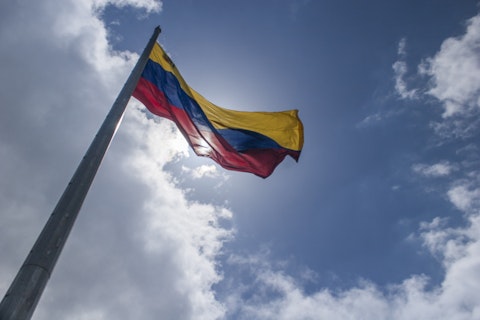This article covers 7 Command Economy Countries and 7 Others with Big Government Presence, offering detailed insights into the countries with centrally planned economies. You can skip our analysis on free economies vs planned economies and go directly to Top 5 Command-Economy Countries in the World.
In a command economy, centralized governmental authority dictates the means of production. In juxtaposition, a free-market economy operates on the principles of supply and demand, where market dynamics determine output levels and price mechanisms. Traditionally, command economies have found footing in socialist or communist regimes, while free-market economies resonate with capitalist systems and democratic societies.
In practicality, economies seldom adhere strictly to either extreme. Rather, they navigate a nuanced continuum, amalgamating facets of both command and free-market structures. For instance, across Europe, pivotal industries may be under state ownership and administration, while in China, a communist regime has sanctioned specialized free trade to flourish. This spectrum showcases the intricate interplay between governmental intervention and market autonomy within diverse economic landscapes.
In a planned economy, the state’s monopoly over resources facilitates the optimal utilization of economies of scale. Nonetheless, this centralized control often fails to incentivize workers adequately, leading to a decline in individual effort. Conversely, in a market-driven economy, the competitive landscape among firms ensures that heightened worker effort is duly recognized and rewarded.
However, this competitive environment may hinder the full exploitation of economies of scale. Instead, per capita output growth in a market-oriented economy thrives on the relentless integration of new technologies, which gradually substitute labor with capital. As a consequence, the growth trajectory of a market economy typically surpasses that of a planned economy, particularly when the incentive to exert effort assumes paramount importance.
The discourse surrounding the merits and drawbacks of market economies versus planned economies is steeped in historical context. One school of thought posits that as industries expand and financial dominance consolidates, the relentless pursuit of maximum profit inevitably corrodes the fabric of free competition.
In this light, proponents argue that a planned economy, with its ability to emulate the intricacies of the price system, may be effective against the erosion of purchasing power. Conversely, critics contend that a planned economy risks stifling individual motivation and stands at odds with the fundamental tenets of the rule of law.
China is one of the best examples of a blend of free market and planned economy, often referred to as a mixed ownership economy. Since its restructuring in 1978, the country has endeavored to facilitate the amalgamation of state and private capital. Ultimately, state and private capital collaborate closely, fostering mutual support and cooperation.
The Market In China
The post-1978 economic reform was a spontaneous, evolutionary process wherein individuals seized emerging opportunities for trade and entrepreneurship, lifting themselves out of poverty. China’s accession to the World Trade Organization (WTO) in December 2001 marked a significant turning point, invigorating the nonstate sector and catalyzing institutional reforms aimed at enhancing competition. These reforms not only fostered economic growth but also laid a solid foundation for further development.
In the two decades following this development, the trade relationship between the United States and China experienced a remarkable expansion. Presently, China stands as one of the largest export markets for U.S. goods and services, while the United States ranks among the top export markets for China.
This robust trade has brought benefits to the United States, including lower prices for consumers and increased profits for corporations. However, the United States remains discontent with certain aspects of its trade relations with China. In pursuit of its economic objectives, the Chinese government has infused subsidies into various industries with the aim of nurturing “national champion” companies.
While some experts criticize these subsidies as wasteful, they also pose challenges for other countries whose companies struggle to compete against such substantial levels of state support. Moreover, the United States contends that many Chinese state-owned enterprises effectively serve as extensions of the government and do not operate under the same market forces as their private counterparts. In contrast, a large number of US industries and sectors are widely unregulated.
Least Regulated Companies in the US
The absence of stringent regulations in the U.S. is evident in the behaviors of various market participants. For instance, the relaxed rules within the real estate industry have facilitated money laundering activities by criminals and kleptocrats and sanctioned foreign nationals through real estate investments.
According to a study released in August 2021 by Global Financial Integrity (GFI), a Washington, D.C.-based think tank, drawing on a database of over 100 international real estate money laundering cases, more than $2.3 billion in illicit funds were laundered through U.S. real estate between 2015 and 2020.
Another arena that lacks stringent regulations is the technology sector, which has been embroiled in numerous legal entanglements throughout its history. One notable example is the Microsoft (NASDAQ: MSFT) antitrust case, which emerged as a prominent legal matter a few decades ago, specifically in the 1990s. U.S. federal regulators initiated legal action against the company in response to its escalating market dominance in the personal computer market.
The Federal Trade Commission launched an investigation to ascertain whether Microsoft (NASDAQ: MSFT) was engaging in monopolistic practices aimed at controlling the personal computer market. Although the initial investigation concluded without charges, the U.S. Department of Justice revived the case in 1998.
The Justice Department filed antitrust charges against Microsoft (NASDAQ:MSFT), alleging that the company’s bundling of additional programs into its operating system was anti-competitive. This practice effectively required consumers to purchase the Windows operating system to access certain applications.
In a move towards increased regulation, The White House collaborated with CVS Health Corp. (NYSE:CVS), Walgreens Boots Alliance Inc. (NASDAQ:WBA), and Walmart Inc. (NYSE:WMT) to promote the benefits of the Inflation Reduction Act — a Health and Human Services Department initiative.
Among its provisions, the act includes measures to cap insulin prices, expand access to adult vaccines, and empower Medicare, the US health program for the elderly, to negotiate prices of expensive drugs manufactured by major pharmaceutical companies. During their joint effort, the coalition emphasized the importance of educating consumers about the new Medicare prescription drug benefits and discussed strategies for pharmacies to assist individuals with filling out forms during Medicaid coverage renewal processes.
The leaders from CVS Health Corp. (NYSE:CVS), Walgreens Boots Alliance Inc. (NASDAQ:WBA), and Walmart Inc. (NYSE:WMT) delved into programs like Extra Help, designed to support low-income seniors and individuals with disabilities in managing premium and medication costs.

Pixabay/Public Domain
Methodology
To determine the 7 Command Economy Countries and 7 Others with Big Government Presence, we used two metrics as major indicators: the 2024 Index of Economic Freedom from The Heritage Foundation, (which measures economic freedom on a scale of 1-100 of scores) and the GDP of the respective countries from World Bank Data. A lower Index of Economic Freedom score suggests that an economy has less economic freedom and a bigger government presence. We have combined these factors with the size of GDPs, and the degree of socialist policies implemented in the countries and based on that, we present the list of 14 most economically regulated countries in the world.
Here is our list of 7 Command Economy Countries and 7 Others with Big Government Presence.
7 Countries with Big Government Presence
14. Burundi
The regulatory environment of Burundi is characterized by a mix of legislation and institutions aimed at governing various sectors of the economy and society. The country’s legal framework encompasses laws and regulations pertaining to finance, trade, labor, environment, and governance.
13. Congo
Congo has undertaken initiatives with limited efficacy to promote responsible business conduct (RBC), urging companies to establish and uphold codes of ethics while emphasizing environmental responsibility. The Labor Code incorporates safeguards for employees, and legal mandates exist to compel businesses to safeguard the environment. Nevertheless, the country lacks a comprehensive legal structure to protect consumer rights, and domestic laws to shield individuals from detrimental business practices are absent.
12. Ethiopia
Since 2018, Ethiopia has experienced significant holistic policy and legislative transformations. As part of this process, numerous laws aimed at facilitating business operations have been introduced. Notably, the Ethiopian Government enacted the Capital Markets Proclamation, establishing a domestic capital market with the explicit goal of advancing the national economy through capital mobilization, fostering financial innovation, and distributing investment risks.
11. Sudan
Businesses contemplating entry into the Sudanese market encounter significant uncertainty attributed to political upheaval, corruption, an ineffective bureaucracy with limited capabilities, a fluctuating regulatory landscape, and challenges within the financial sector. The existing government faces legitimacy issues, compounded by political instability that has led many local companies to postpone their investment initiatives.
To boost dwindling government revenues following the military takeover in 2021, the administration has raised the business tax to 30% in 2022 and escalated fees on the private sector.
10. Bolivia
The 2009 constitution of Bolivia mandated the nationalization of enterprises in “strategic” sectors, encompassing industries such as fossil fuels, mining, telecommunications, and electricity. Under the leadership of President Luis Arce and the Movement Towards Socialism (MAS) government, there has been a strong inclination toward nationalization and an economic model centered on import substitution.
9. China
In recent years, China is experiencing decelerating growth and a progressively restrictive regulatory landscape. While the emergence of COVID-19 undoubtedly played a significant role in this slowdown, unexpected regulatory measures implemented by policymakers have further complicated the business environment, affecting market sentiment overall.
8. Turkmenistan
In Turkmenistan, the absence of a well-defined rule of law, an unclear regulatory structure, and widespread corruption continue to pose significant challenges. Contracts frequently go to companies closely connected to the President’s family. Moreover, the government maintains strict control over foreign exchange movements, imposing limitations on currency conversion that hinder the repatriation of profits or payments to foreign suppliers.
7 Command Economies in the World
7. Zimbabwe
The recurring practice of implementing ad hoc trade restrictions, including exchange controls and local content policies, to shield inefficient domestic producers creates a challenging environment for Zimbabwe’s private sector.
The government’s frequent policy shifts, often applied inconsistently and influenced by political or personal considerations, pose significant obstacles to business planning. Zimbabwe’s regulatory landscape remains intricate, with businesses encountering difficulties registering and operating within the country.
6. North Korea
The Democratic People’s Republic of Korea (DPRK) continues to be regarded as one of the most oppressive nations globally. Under the authoritarian rule of Kim Jong Un, the government responded to international pressures and the COVID-19 pandemic in 2021 by further isolating itself and intensifying repression. Fearful obedience among the populace is enforced through threats of execution, imprisonment, enforced disappearances, and forced labor in detention and prison camps.
Click to continue reading and see the Top 5 Command-Economy Countries in the World.
Suggested Articles:
- 25 Countries with Most Gold Reserves in 2024
- 25 Companies with the Best Benefits and Perks
- 20 Countries That Read the Most in the World
Disclosure. None. 7 Command Economy Countries and 7 Others with Big Government Presence is originally published on Insider Monkey.





